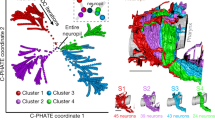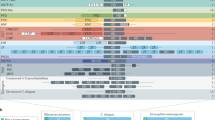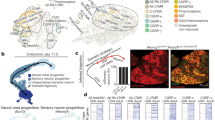Abstract
Despite the great diversity of shapes exhibited by different classes of nerve cells, nearly all neurons share one feature in that they have a single axon and several dendrites. The two types of processes differ in their morphology, in their rate of growth, in the macromolecular composition of their cytoskeletons and surface membranes, and in their synaptic polarity1,2. When hippocampal neurons are dissociated from the embryonic brain and cultured, they reproducibly establish this basic form with a single axon and several dendrites, despite the absence of any spatially organized environmental cues, and without the need for cell to cell contact3–7. We have cut the axons of young hippocampal neurons within a day of their development: in some cases the initial axon regenerated, but more frequently one of the other processes, which if undisturbed would have become a dendrite, instead became the axon. Frequently the stump of the original axon persisted following the transection and subsequently became a dendrite. Evidently the neuronal processes that first develop in culture have the capacity to form either axons or dendrites. The acquisition of axonal characteristics by one neuronal process apparently inhibits the others from becoming axons, so they subsequently become dendrites.
This is a preview of subscription content, access via your institution
Access options
Subscribe to this journal
Receive 51 print issues and online access
$199.00 per year
only $3.90 per issue
Buy this article
- Purchase on Springer Link
- Instant access to full article PDF
Prices may be subject to local taxes which are calculated during checkout
Similar content being viewed by others
References
1. Peters, A., Palay, S. & Webster, H. de F. The Fine Structure of the Nervous System: The Neurons and Supporting Cells (Saunders, Philadelphia, 1976). 2. Banker, G. A. & Waxman, A. B. in Intrinsic Determinants of Neuronal Form and Function (eds Lasek, R. J. & Black, M. B.) (Liss, New York, 1987). 3. Dotti, C. G., Sullivan, C. A. & Banker, G. A. /. Neurosci. (in the press). 4. Bartlett, W. P. & Banker, G. A. /. Neurosci. 4, 1944-1953 (1984). 5. Bartlett, W. P. & Banker, G. A. J. Neurosci. 4, 1954-1965 (1984). 6. Caceres, A., Banker, G. A., Steward, O., Binder, L. & Payne, M. R. Devl Brain Res. 13, 314-318 (1984). 7. Banker, G. A. & Mazurkiewicz, J. E. Soc. Neurosci. Abstr. 8, 696 (1982). 8. Shaw, G. & Bray, D. Expl Cell Res. 104, 55-63 (1977). 9. Wessells, N. K., Johnson, S. R. & Nuttall, R. P. Expl Cell Res. 117, 335-345 (1978). 10. Caceres, A., Banker, G. A. & Binder, L. J. Neurosci. 6, 714-722 (1986). 11. Hall, G. F. & Cohen, M. J. Science 222, 518-521 (1983). 12. Linda, H., Risling, M. & Cullheim, S. Brain Res. 358, 329-333 (1985). 13. Eccles, J. C., Libet, B. & Young, B. R. /. Physiol., Land. 143, 11-40 (1958). 14. Kuno, M. & Llinas, R. J. Physiol, Lond. 210, 807-821 (1970). 15. Titmus, M. J., Faber, D. S. & Zottoli, S. J. J. Neurophysiol. 55, 1424-1439 (1986). 16. Hamori, J., Lakos, I. & Mezey, E. J. Hirnforsch. 21, 391-407 (1980). 17. Banker, G. A. & Cowan, W. M. Brain Res. 126, 397-425 (1977).
Author information
Authors and Affiliations
Rights and permissions
About this article
Cite this article
Dotti, C., Banker, G. Experimentally induced alteration in the polarity of developing neurons. Nature 330, 254–256 (1987). https://doi.org/10.1038/330254a0
Received:
Accepted:
Issue Date:
DOI: https://doi.org/10.1038/330254a0
This article is cited by
-
PAR3–PAR6–atypical PKC polarity complex proteins in neuronal polarization
Cellular and Molecular Life Sciences (2018)
-
Discovery of long-range inhibitory signaling to ensure single axon formation
Nature Communications (2017)
-
The MT2 receptor stimulates axonogenesis and enhances synaptic transmission by activating Akt signaling
Cell Death & Differentiation (2015)
-
PDZ interaction of Vangl2 links PSD-95 and Prickle2 but plays only a limited role in the synaptic localisation of Vangl2
Scientific Reports (2015)
-
Single-cell axotomy of cultured hippocampal neurons integrated in neuronal circuits
Nature Protocols (2014)
Comments
By submitting a comment you agree to abide by our Terms and Community Guidelines. If you find something abusive or that does not comply with our terms or guidelines please flag it as inappropriate.



